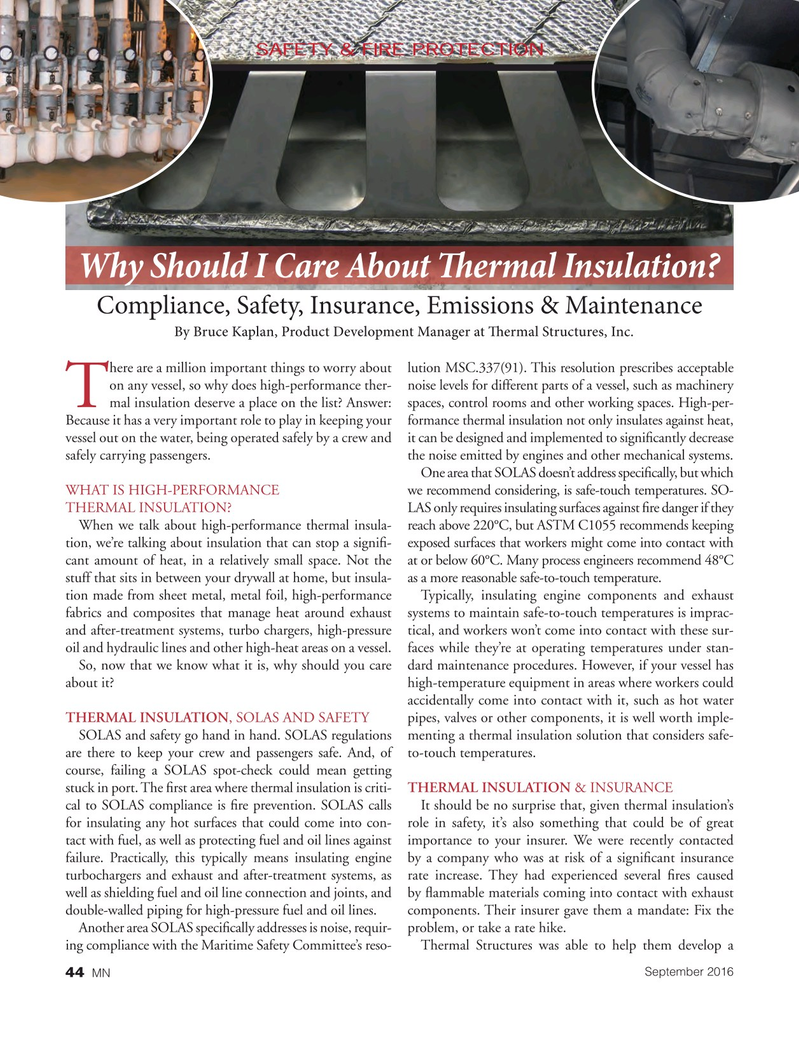
Page 44: of Marine News Magazine (September 2016)
Offshore Annual
Read this page in Pdf, Flash or Html5 edition of September 2016 Marine News Magazine
SAFETY & FIRE PROTECTION
Why Should I Care About T ermal Insulation?
Compliance, Safety, Insurance, Emissions & Maintenance
By Bruce Kaplan, Product Development Manager at T ermal Structures, Inc.
here are a million important things to worry about lution MSC.337(91). This resolution prescribes acceptable on any vessel, so why does high-performance ther- noise levels for different parts of a vessel, such as machinery
Tmal insulation deserve a place on the list? Answer: spaces, control rooms and other working spaces. High-per-
Because it has a very important role to play in keeping your formance thermal insulation not only insulates against heat, vessel out on the water, being operated safely by a crew and it can be designed and implemented to signi? cantly decrease safely carrying passengers. the noise emitted by engines and other mechanical systems.
One area that SOLAS doesn’t address speci? cally, but which
WHAT IS HIGH-PERFORMANCE we recommend considering, is safe-touch temperatures. SO-
THERMAL INSULATION? LAS only requires insulating surfaces against ? re danger if they
When we talk about high-performance thermal insula- reach above 220°C, but ASTM C1055 recommends keeping tion, we’re talking about insulation that can stop a signi? - exposed surfaces that workers might come into contact with cant amount of heat, in a relatively small space. Not the at or below 60°C. Many process engineers recommend 48°C stuff that sits in between your drywall at home, but insula- as a more reasonable safe-to-touch temperature. tion made from sheet metal, metal foil, high-performance Typically, insulating engine components and exhaust fabrics and composites that manage heat around exhaust systems to maintain safe-to-touch temperatures is imprac- and after-treatment systems, turbo chargers, high-pressure tical, and workers won’t come into contact with these sur- oil and hydraulic lines and other high-heat areas on a vessel. faces while they’re at operating temperatures under stan-
So, now that we know what it is, why should you care dard maintenance procedures. However, if your vessel has about it? high-temperature equipment in areas where workers could accidentally come into contact with it, such as hot water
THERMAL INSULATION, SOLAS AND SAFETY pipes, valves or other components, it is well worth imple-
SOLAS and safety go hand in hand. SOLAS regulations menting a thermal insulation solution that considers safe- are there to keep your crew and passengers safe. And, of to-touch temperatures.
course, failing a SOLAS spot-check could mean getting stuck in port. The ? rst area where thermal insulation is criti- THERMAL INSULATION & INSURANCE cal to SOLAS compliance is ? re prevention. SOLAS calls It should be no surprise that, given thermal insulation’s for insulating any hot surfaces that could come into con- role in safety, it’s also something that could be of great tact with fuel, as well as protecting fuel and oil lines against importance to your insurer. We were recently contacted failure. Practically, this typically means insulating engine by a company who was at risk of a signi? cant insurance turbochargers and exhaust and after-treatment systems, as rate increase. They had experienced several ? res caused well as shielding fuel and oil line connection and joints, and by ? ammable materials coming into contact with exhaust double-walled piping for high-pressure fuel and oil lines. components. Their insurer gave them a mandate: Fix the
Another area SOLAS speci? cally addresses is noise, requir- problem, or take a rate hike. ing compliance with the Maritime Safety Committee’s reso- Thermal Structures was able to help them develop a
September 2016
MN 44
MN Sept16 Layout 32-49.indd 44 8/22/2016 10:15:07 AM

 43
43

 45
45
